Nvidia GeForce RTX 2080 Super Founders Edition review: A modest upgrade to a powerful GPU - ehlersorproclen43
At a Glance
Expert's Rating
Pros
- Excellent 1440p and good 4K gaming public presentation
- Supports period ray tracing and DLSS
- Nvidia's metallic Founders Version design is gorgeous
- Fastest GDDR6 memory available
- Supports multi-GPU SLI configurations
Cons
- Not much faster than creative RTX 2080
- Shaft of light traced games picking up steamer, only still relatively rare
- RTX 2070 Super serves same basic needs at much bring dow Mary Leontyne Pric
Our Verdict
The Nvidia GeForce RTX 2080 Super Founders Edition is the second most-powerful GPU ever so released and great for 4K or ultra-smart 1440p play, but this modest kick upstairs loses its unique esteem proposal in the new-look RTX Super lineup.
Best Prices Now

$699
Nvidia's $700 GeForce RTX 2080 Super is the moment-fastest artwork tease ever free, a screaming piece of outfit that chews through games even at 4K solving. You'd be very happy buying it. But information technology just doesn't feel as, advantageously, super Eastern Samoa its lower-priced siblings.
The GeForce RTX 2060 Super and 2070 Super burst onto the tantrum early in July and changed the whole malodourous-end graphics carte landscape painting, rendering individual other GPUs instantly obsolete. The $400 RTX 2060 Super delivered performance on par with the original $500 RTX 2070, while the new $500 RTX 2070 Super came within spitting distance of the original $700 RTX 2080. It wasn't sufficiency to kill AMD's Radeon revival, but the eldest two Nvidia Super GPUs lived up to their name.
The GeForce RTX 2080 Super? It's a undersized bit faster than its vanilla namesake—but only by a hair. The brute GeForce RTX 2080 Ti has nothing to fear.
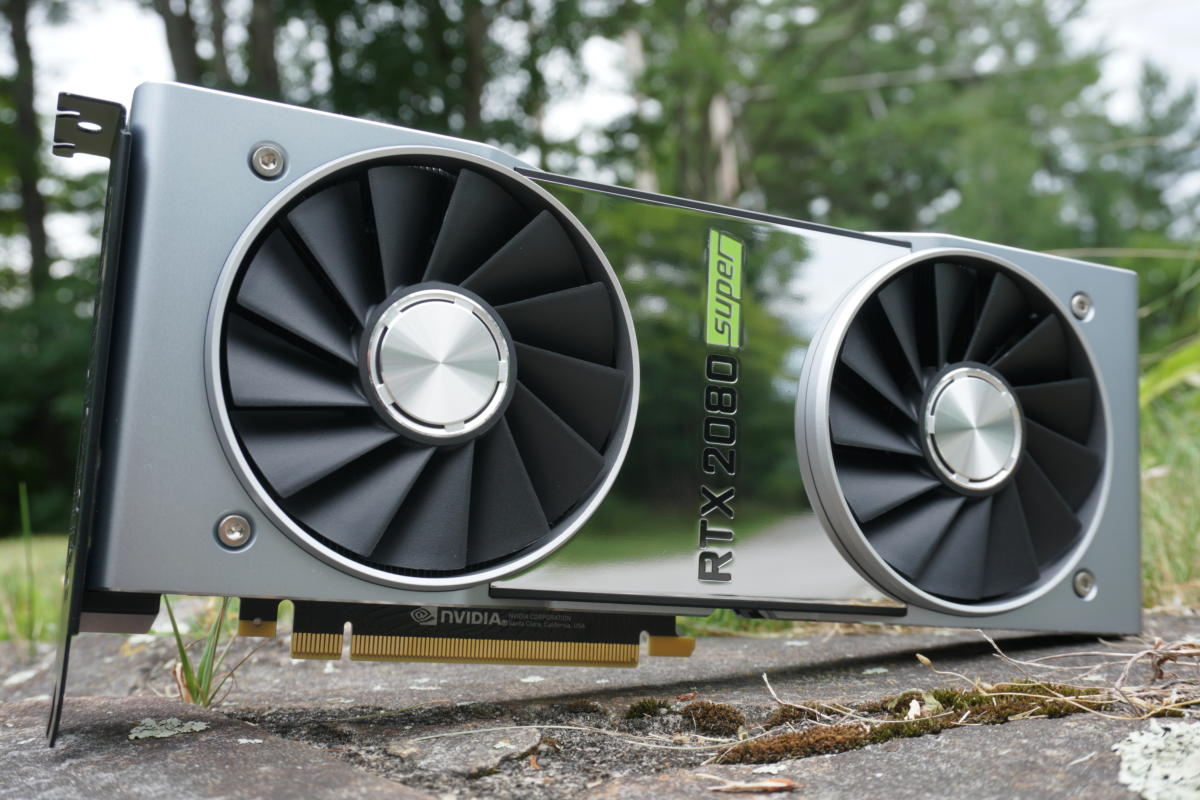 Brad Chacos/IDG
Brad Chacos/IDG GeForce RTX 2080 Comprehensive: Specs and features
The GeForce RTX 2080 Superintendent Founders Variant we're testing nowadays sticks to reference speeds and will set you back $699, Nvidia's MSRP for this GPU. That's in line to the original RTX 2080 Atomic number 26, which commanded a $100 price superior over MSRP and included a clement overclock. Customized versions of the RTX 2080 Super will also be available now by Nvidia board partners like EVGA, Asus, and Gigabyte.
Speaking of reference specs, let's look at the core GPU itself. Here's how the GeForce RTX 2080 Super oodles skyward against the original RTX 2080 and the finis-gen GTX 1080:
 Nvidia
Nvidia The GeForce RTX 2080 Super is in a slightly different situation than the other Super cards. While the RTX 2060 Super shifted to a more fully enabled version of the TU106 GPU to achieve its higher performance, and the RTX 2070 Super made the leap from TU106 to a cut-down feather version of the many potent TU104 GPU base in the original RTX 2080, that seminal RTX 2080 already deployed a mostly maxed-out version of TU104. Nvidia decided against shifting the 2080 Super up to a cut-weak variation of the mammoth TU102 GPU found in the RTX 2080 Te. It's instead using a riddled-fat interlingual rendition of TU104 with 48 streaming multiprocessors, up from 46 SMs in the original. For comparability, the RTX 2060 and 2070 Super models added quatern SMs each to achieve their monstrous performance jumps.
Adding more cores isn't the only instrument in Nvidia's armory. The GeForce RTX 2080 Super is the first consumer graphics placard to ship with GDDR6 memory clocked at a speedy 15.5Gb/s alternatively of the standard 14Gbps. That boosts the boilers suit memory bandwidth from the 448GB/s available in other GeForce RTX and Radeon RX 5700 GPUs all the room to 496GB/s, which can help hike performance in some scenarios. The company also increased clock speeds across the panel with the RTX 2080 Super.
Nvidia says the cumulative tweaks help the RTX 2080 Super perform up to 10 percent faster than the avant-garde RTX 2080, and that it's about 6 percent faster on fair. The reference point-specification RTX 2080 A-one Founders Edition runs about 5 percent faster than the original slenderly overclocked RTX 2080 Fe for $100 less, Nvidia says. Our breakaway testing confirms mild gains.
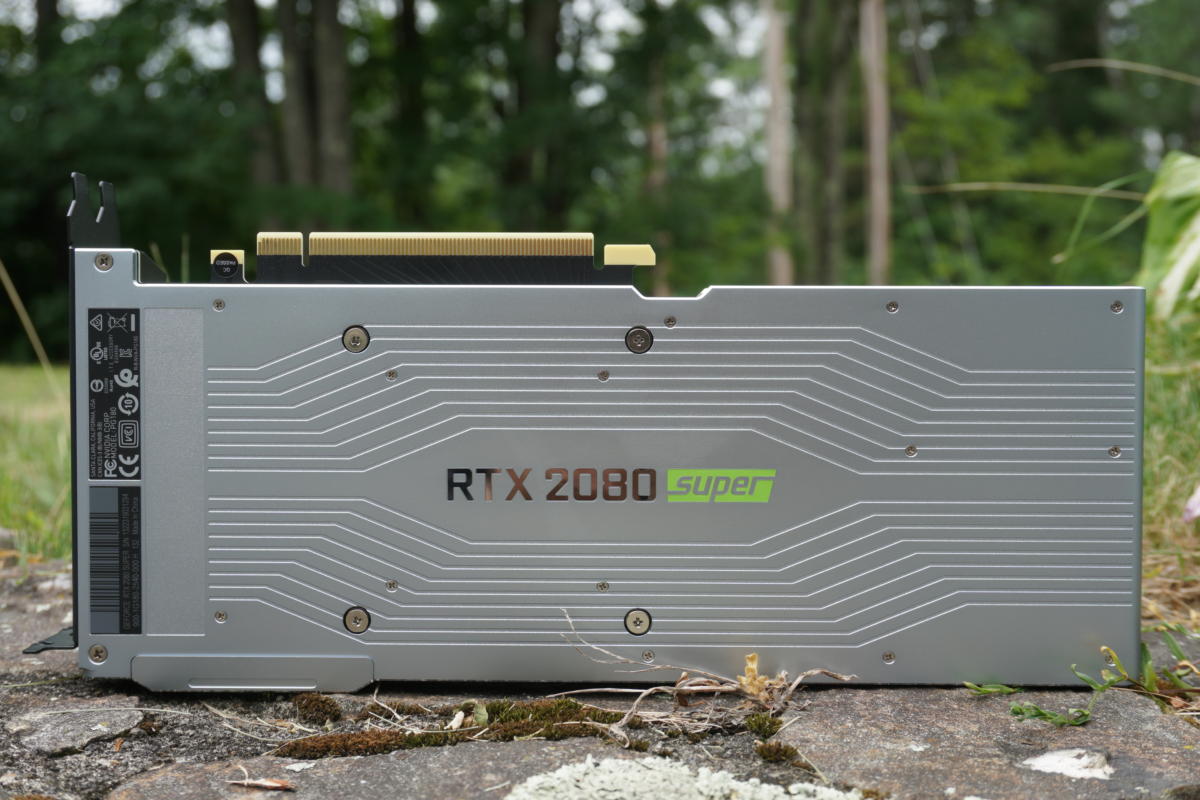 Brad Chacos/IDG
Brad Chacos/IDG The GeForce RTX 2080 Super Founders Edition sticks to the same antimonial-clad cooler design every bit the freehand, though the domain between its dual-axial fans make a mirror-polished instead of spurt-black finish. It's expend-exsanguine gorgeous. The larboard layout cadaver the same as well, with three DisplayPorts and single HDMI and USB-C VirtualLink connections.
While the card needs the Saami 8-pin and 6-pin power connections American Samoa the original version, the power requirements have gone up to lodge the extra oomph. Nvidia rates the RTX 2080 Super FE's add up add-in power at 250 watts, compared to the flavouring RTX 2080's 215W. You can besides run this card in a multi-GPU SLI setup.
Of course, the RTX 2080 Super comes wealthy with tensor and RT cores dedicated to real-time ray tracing and Bradypus tridactylus-enhanced anti-aliasing, which you can learn entirely about in our Alan Turing GPU deep-diving. To turn those muscles, Nvidia's moving in free copies of Wolfenstein: Youngblood and Remedy's Ascendancy with every RTX 20-series purchase, for a limited time. Both games assume advantage of those carving-edge technologies, and after a slow start, ray trace is lastly gaining traction.
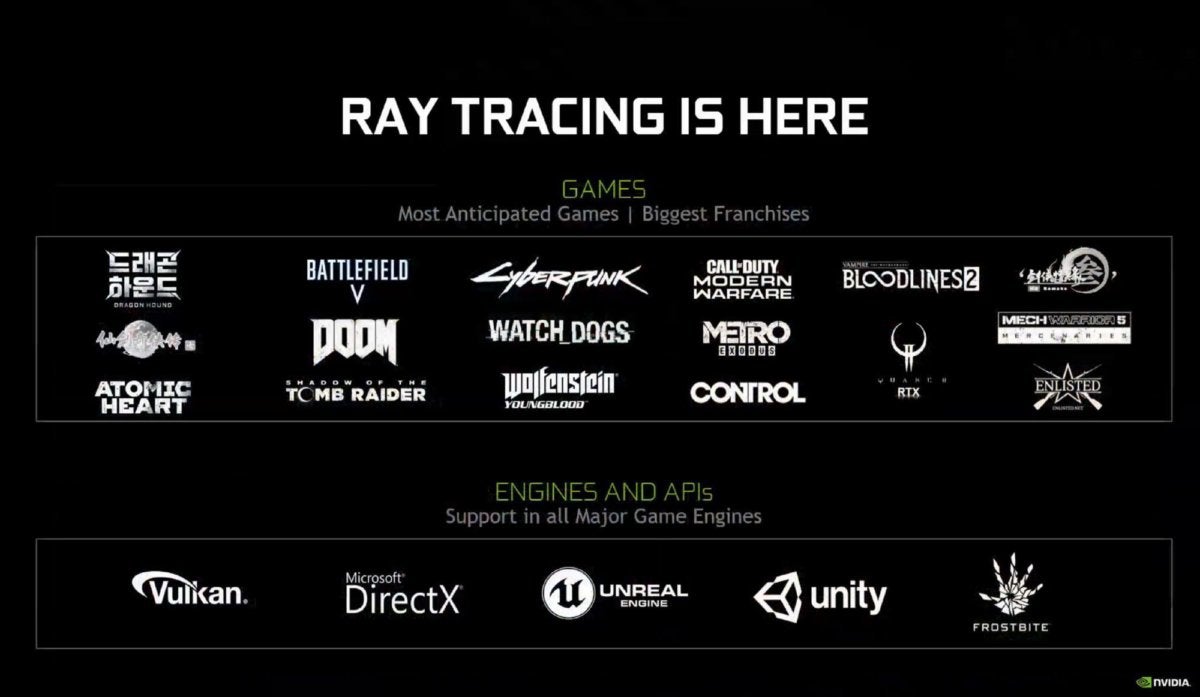 Nvidia
Nvidia Metro Exodus is the current gold standard, with ray tracing substantially dynamic the reckon and feel for of the game, butShade off of the Tomb Raider, Battlefield V, Assetto Corsa, andQuake II RTX also support the technology. Ray tracing got a huge vote of confidence at E3 2019 besides, withCyberpunk 2077, Call Of Tariff: Innovative Warfare, Doom Eternal, Wolfenstein: Youngblood, Lamia: The Masquerade—Bloodlines 2, Redress'sAscendence, andTake in Dogs: Hostconfirmed to include the engineering science. Most of those cracked our favorite games of E3 2019.
Several littler titles as wel plan to bake in real-metre ray tracing now that all the major game engines tolerate it. Ray trace is unmoving niche, but IT's truly revolutionary and picking up hurrying with the arrival of hardware resourceful of running the ultra-intensive tasks.
That's everything you need to know or so the GeForce RTX 2080 Crack Founders Edition. On to the test Bench!
Next page: Our try out system, benchmarks begin
Our test system of rules
Our holy graphics card test system is packed with some of the fastest completing components available to put any potential carrying into action bottlenecks forthrightly on the GPU. Most of the hardware was provided by the manufacturers, but we purchased the cooler and storage ourselves.
- Intel Meat i7-8700K processor ($350 on Amazon)
- EVGA CLC 240 winking-loop liquid tank ($120 on Amazon)
- Asus Maximus X Fighter motherboard ($395 on Amazon)
- 64GB HyperX Predator RGB DDR4/2933 ($420 on Amazon)
- EVGA 1200W SuperNova P2 power supply ($230 on Amazon)
- Corsair Crystal 570X RGB case, with front and top panels removed and an extra nates fan installed for improved airflow ($130 on Amazon)
- 2x 500GB Samsung 860 EVO SSDs ($78 each on Amazon)
We'Ra comparing the $700 GeForce RTX 2080 Superintendent Founders Variant against Nvidia's Founders Edition models of the $1,200 GeForce RTX 2080 Ti, $800 RTX 2080, and $600 RTX 2070. These original FE models came with lean overclocks and key toll premiums, though the first RTX 2070 and 2080 are now being killed off with the Super series' arrival. We're besides including the Founders Edition versions of the $400 RTX 2060 Super and $500 RTX 2070 Fantastic, which (like the RTX 2080 Super) stick to stock glasses and MSRP pricing. Finally, AMD's rival $700 Radeon VII and $400 Radeon RX 5700 XT are also included in the comparison.
All prices cited are launch MSRP; you can oftentimes find these cards cheaper on the streets these days.
All plot is tested using its in-game benchmark at the highest feasible art presets, with VSync, frame rate caps, and all GPU vendor-specialised technologies—like AMD TressFX, Nvidia GameWorks options, and FreeSync/G-Sync—disabled, and temporal opposed-aliasing (TAA) enabled to push these lofty-end cards to their limits. If anything differs from that, we'll mention it. We run from each one benchmark at least three times and list the average ensue for each trial.
Because the GeForce RTX 2080 A-one is scarcely a slightly quicker RTX 2080 at its core, we'Re passing to skip our accustomed commentary after each bench mark and let the testing speak for itself.
Gaming performance benchmarks
Division 2
Allow's start with the latest games. The Division 2 is one of the primo spoiler-shooters of all time created. The pleasant-tasting visuals generated by Ubisoft's Snowdrop locomotive make it even easier to get lost in post-apocalyptic Washington D.C. The built-in benchmark cycles through four "zones" to test an raiment of environments. We test with the DirectX 12 renderer enabled. Information technology provides better execution crosswise-the-board than the DX11 renderer, just requires Windows 10.
 Brad Chacos/IDG
Brad Chacos/IDG Far Cry: New Dawn
Some other Ubisoft style, Far Cry: New Morning drags Far Cry 5's wonderful gameplay into a post-apocalyptic future of its own, though this vision is a good deal more orotund—and pink—than The Class 2's bleak setting. The game runs on the latest version of the long-gushing Dunia engine, and it's slightly more strenuous than Far Cry 5's built-in benchmark.
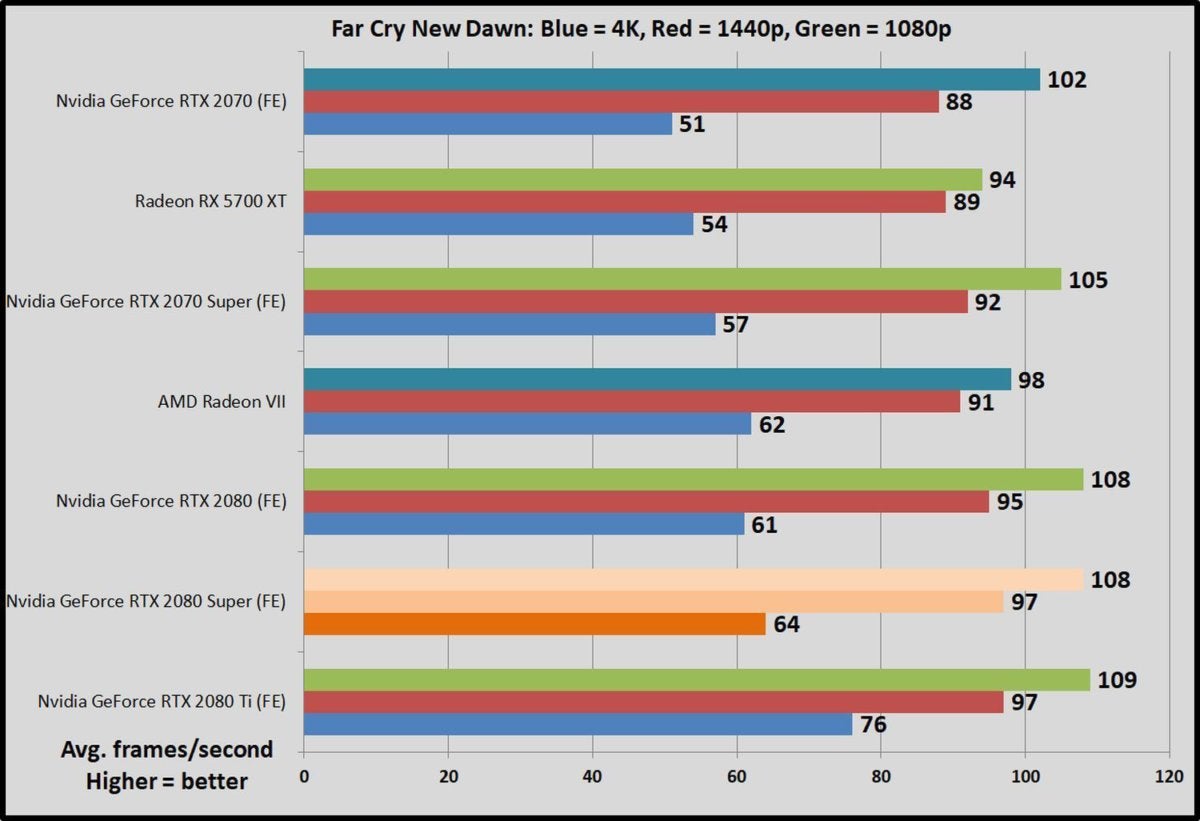 Brad Chacos/IDG
Brad Chacos/IDG Next page: Gaming benchmarks continue
Strange Brigade
Strange Brigade ($50 on Humble) is a cooperative third-person shooter where a team of adventurers blasts through hordes of mythological enemies. Information technology's a technological showcase, well-stacked around the side by side-gen Vulkan and DirectX 12 technologies and infused with features like HDR support and the ability to toggle asynchronous compute on and off. It uses Rebellion's custom Azure engine. We test the DX12 renderer with async compute sour.
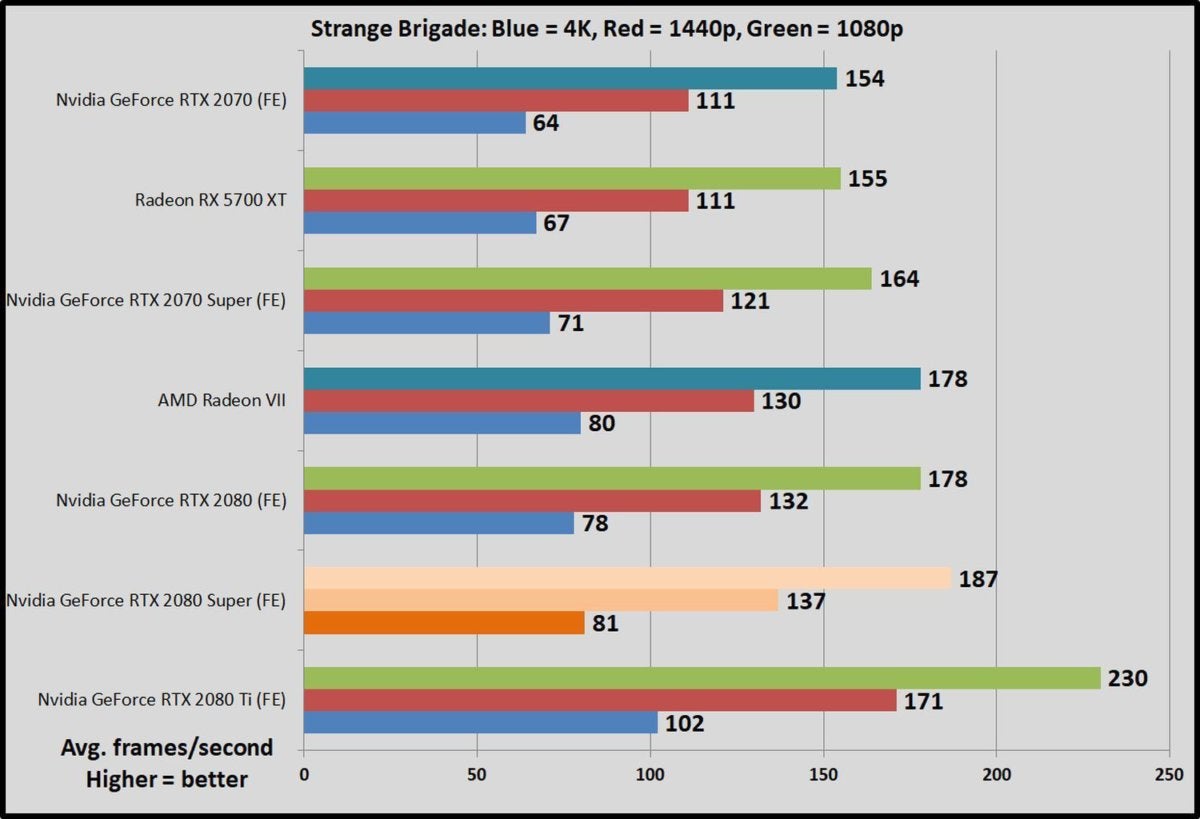 Brad Chacos/IDG
Brad Chacos/IDG Shadow of the Tomb Raider
Shadow of the Tomb Freeboote ($60 on Humble) concludes the bring up trilogy, and it's utterlybeautiful. Square Enix optimized this game for DX12, and recommends DX11 only when you're victimization older hardware surgery Windows 7, so we test with that.Shadow of the Grave Raider uses an enhanced interlingual rendition of the Foundation engine that also poweredRise of the Tomb Raider.
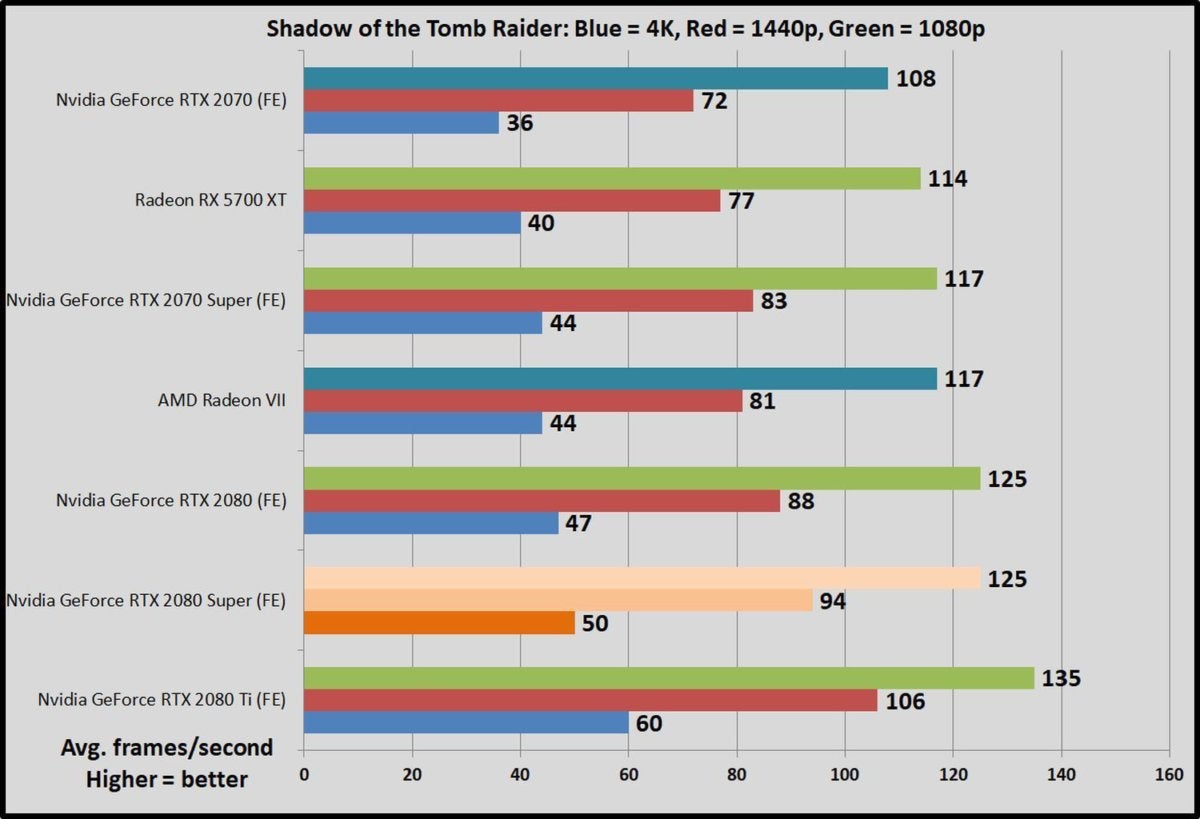 Brad Chacos/IDG
Brad Chacos/IDG Ghost Recon Wildlands
Move over,Crysis. If you crank all the graphics options up to 11, like we do for these tests,Ghost Recon Wildlands($50 connected Humble) and its AnvilNext 2.0 engine absolutelymelt GPUs, even with a sequel due ulterior this year. It's by far the most strenuous game in our suite, eve with newer stunners like Division 2 in the mix in.
 Brad Chacos/IDG
Brad Chacos/IDG F1 2018
The up-to-the-minute in a long line of successful games,F1 2018($60 on Menial) is a jewel to mental test, supplying a wide array of both graphical and benchmarking options—making it a much to a greater extent reliable (and amusive) option that theForzaseries. It's well-stacked on the fourth version of Codemasters' buttery-repand Ego game engine. We essa two laps on the Commonwealth of Australi course, with vivid skies.
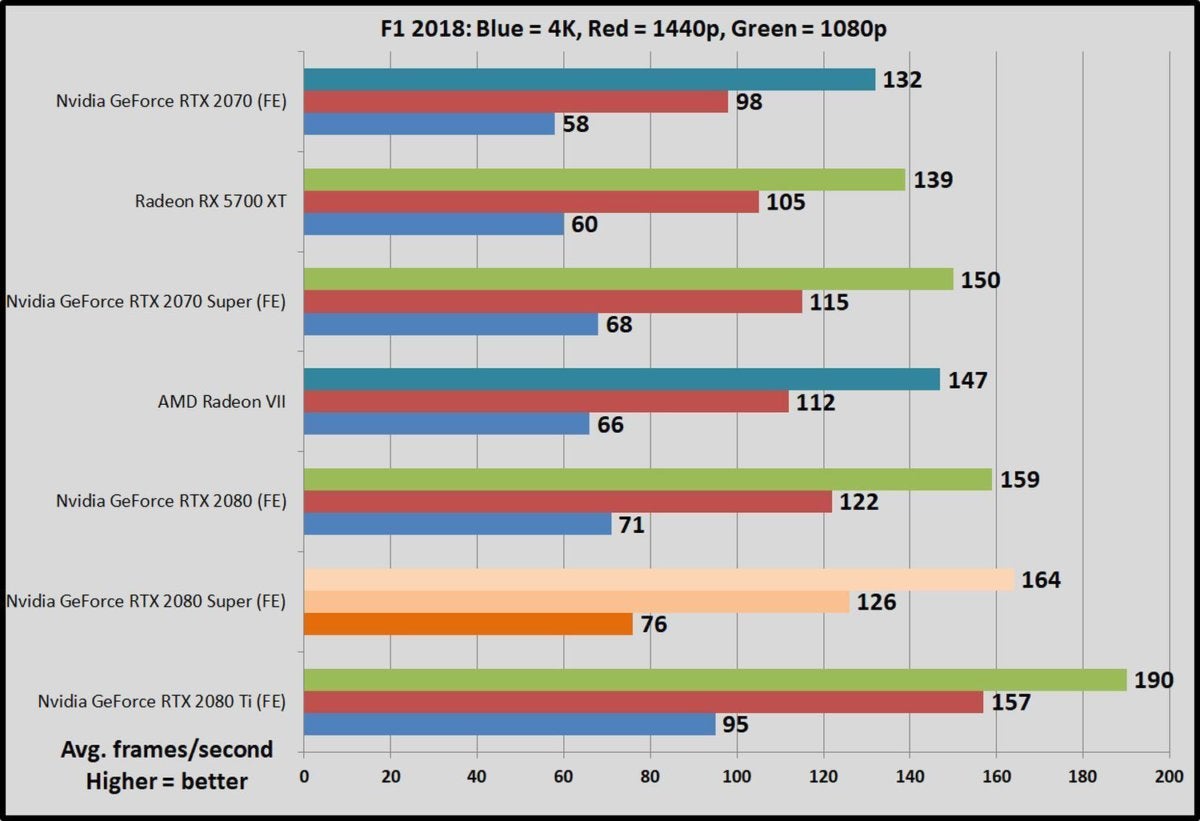 Brad Chacos/IDG
Brad Chacos/IDG Adjacent Sri Frederick Handley Page: Gaming and ray tracing benchmarks
GTA V
We're going to wind things up with a unfit that ISN't really a visual barn-burner, but still tops the Steam charts sidereal day in and day out. We testGrand larceny Auto V ($30 on Humble) with all options turned to Very High gear, every Progressive Graphics options demur extended shadows enabled, and FXAA.GTA Vruns on the RAGE engine and has received substantial updates since its first launch.
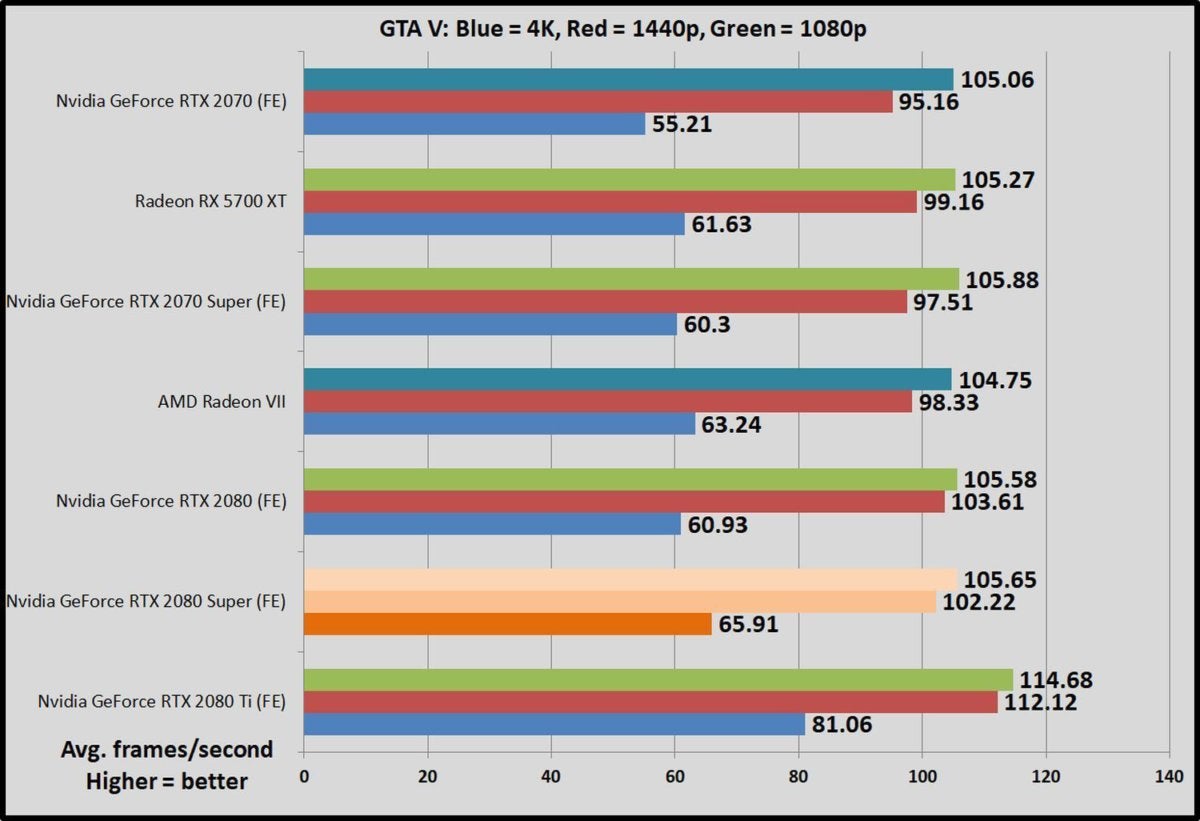 Brad Chacos/IDG
Brad Chacos/IDG Real-time ray tracing performance
Nvidia crammed more consecrated period ray trace hardware into the Super GPUs, so we wanted to put that to the test, too.
Shade off of the Tomb Raider supports ray traced shadows, and IT doesn't forthwith tank your frame rate, especially when paired with Nvidia's Bass-Learning Super Sampling (DLSS) technology. DLSS uses the devoted tensor cores in RTX GPUs to practice AI to perform supersampling with a lower performance hit, reclaiming several of the frame in rate lost by facultative real-time ray tracing. If you want to know more nitty-mettlesome details, cost sure to run down our deep-plunk into the Nvidia Turing GPU architecture. Information technology's fascinating stuff.
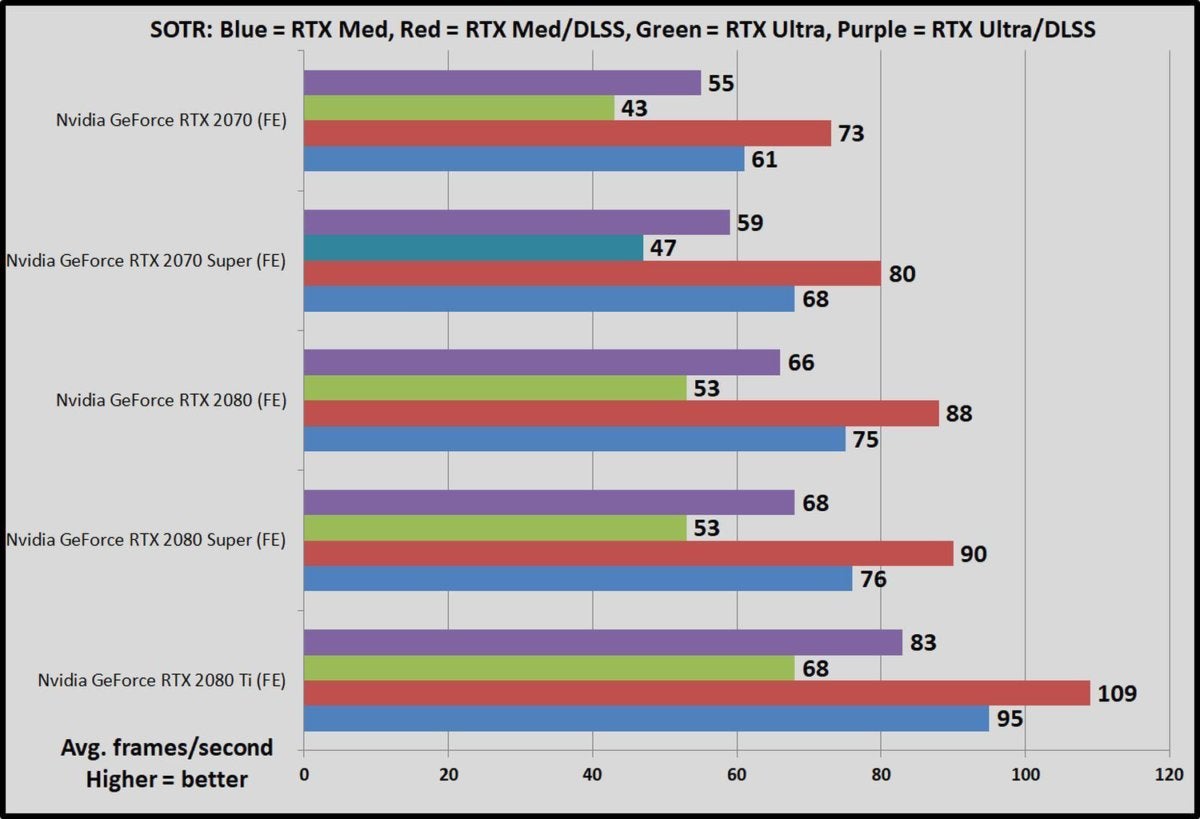 Brad Chacos/IDG
Brad Chacos/IDG We reliable ray tracing performance with RTX Shadows set to both Moderate and Ultra settings, and DLSS on and off for each, using the game's constitutional benchmark. Resolution was prepare to 2560×1440 for all runs. Radeon cards lack dedicated ray tracing hardware and cannot enable these options, so we didn't benchmark some of AMD's offerings.
The RTX 2080 Super doesn't provide much of a boost over the vanilla RTX 2080, only information technology is noticeably faster than the RTX 2070 Super in factual-sentence ray tracing public presentation.
Close page: Power guide, thermals, and synthetic benchmarks
Power haulage, thermals, and synthetics
We also tested the GeForce RTX 2080 Superior Founders Edition using 3DMark's extremely proud Fire Smasher synthetic benchmark. Fervidness Strike runs at 1080p, Fire Strike Extreme runs at 1440p, and Fuel Strike Ultra runs at 4K resolution. All render the same scene, but with more intense graphical effects as you rise the scale, so that Extreme and Ultra flavors stress GPUs even more than. We record the graphics grudge to excrete variance from the CPU.
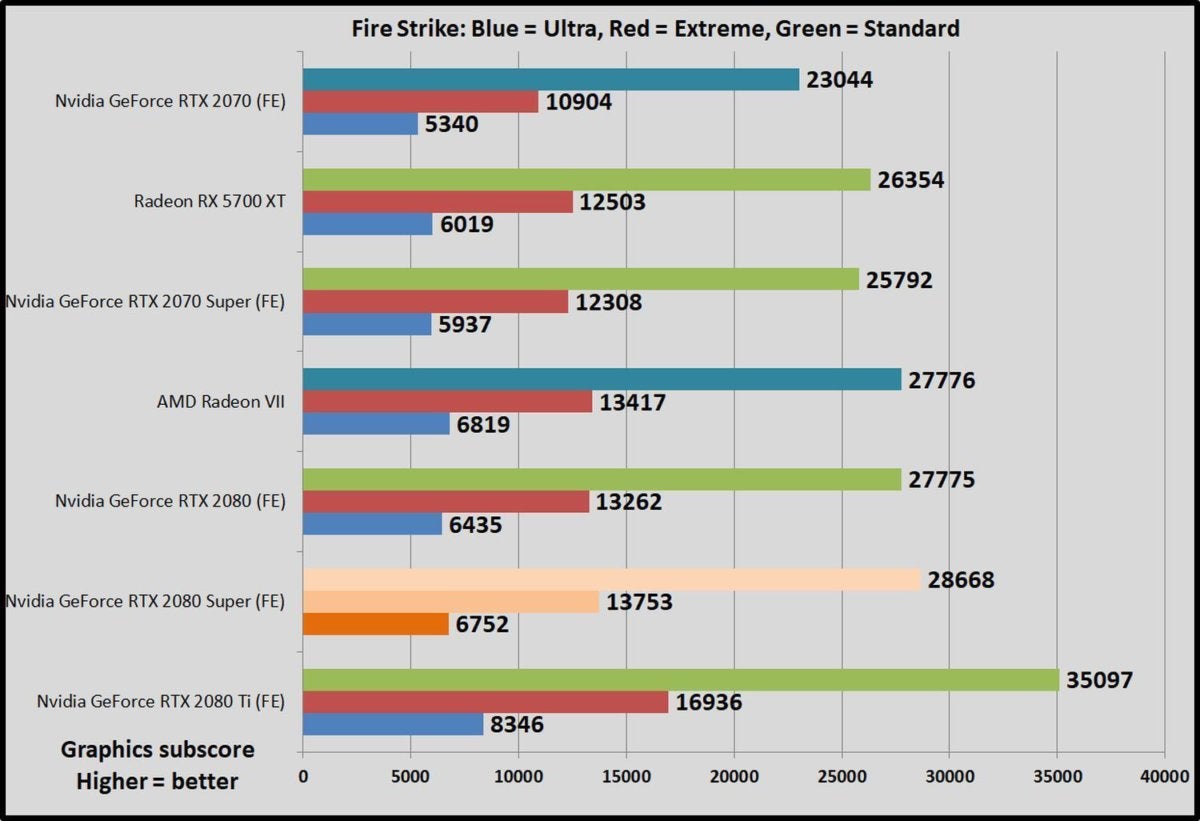 Brad Chacos/IDG
Brad Chacos/IDG We test thermals by leaving either AMD's Wattman (for Radeon GPUs) or EVGA's Preciseness X1 (for GeForce GPUs) open during theF1 2018 five-lap power draw test, noting the highest maximum temperature at the end.
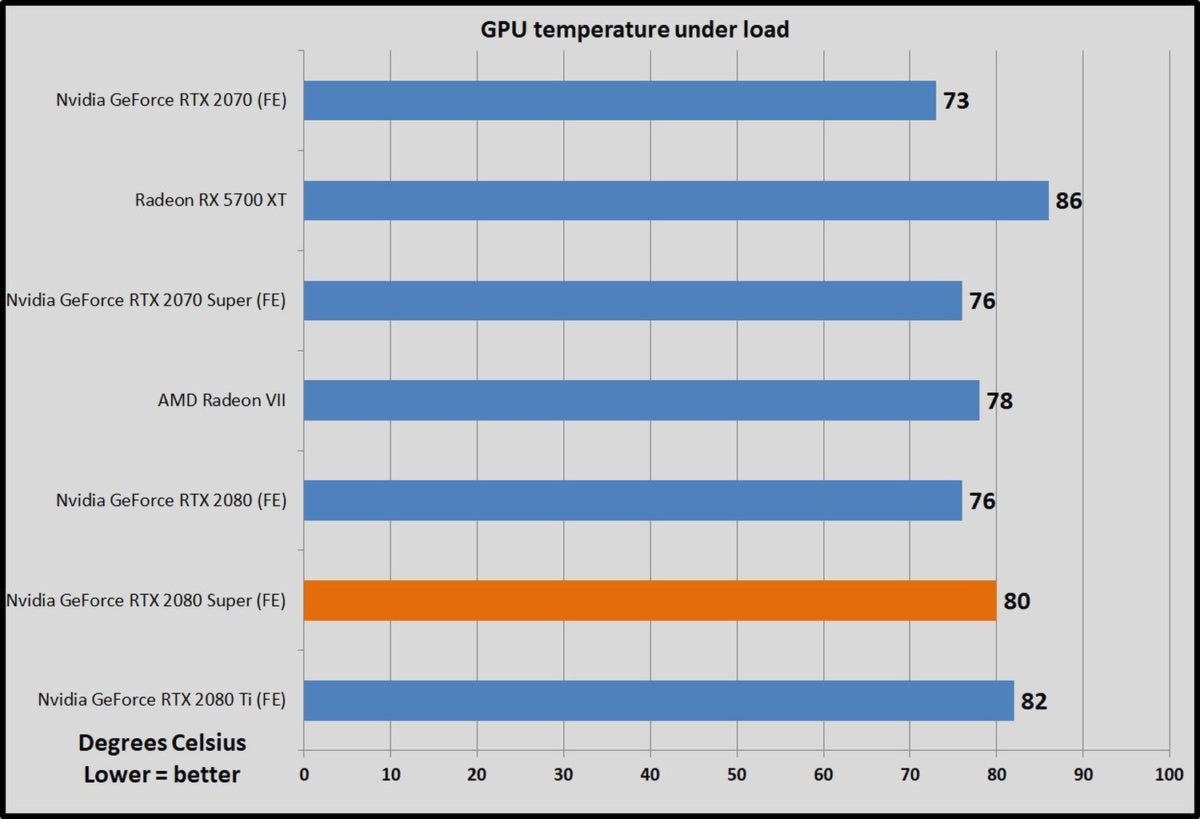 Brad Chacos/IDG
Brad Chacos/IDG We test power draw by iteration theF1 2018 benchmark for about 20 minutes after we've benchmarked everything else, and noting the highest reading connected our Watts Finished In favor meter. The initial part of the race, where all competing cars are onscreen simultaneously, tends to exist the almost demanding portion.
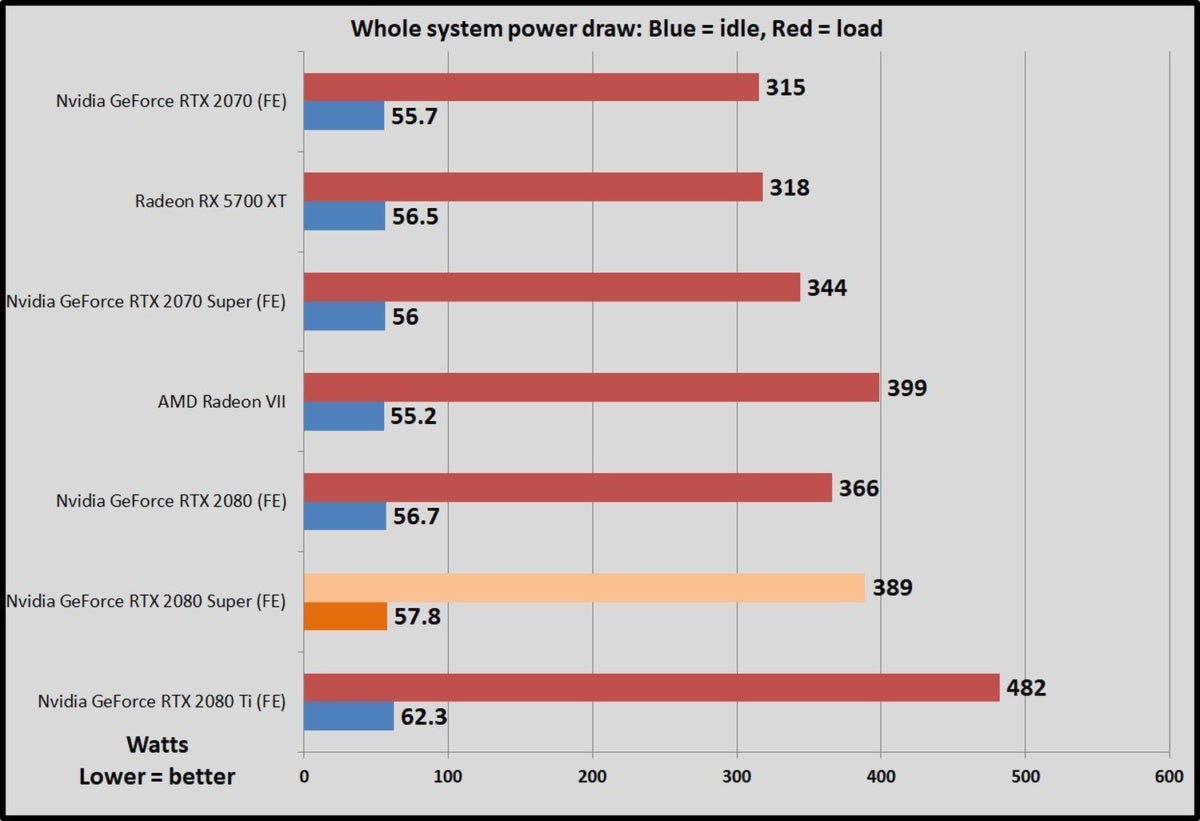 Brad Chacos/IDG
Brad Chacos/IDG Unsurprisingly, the more powerful, quicker-clocked RTX 2080 Superior draws to a greater extent power and runs hotter than its vanilla namesake. The dual-axial tank design finds a comfortable middle ground: IT's not soft, only it's also not annoyingly flashy. Custom cooler designs should bring the overall temperatures down quite a little.
Next page: Should you buy the GeForce RTX 2080 Super?
Should you buy the GeForce RTX 2080 Super?
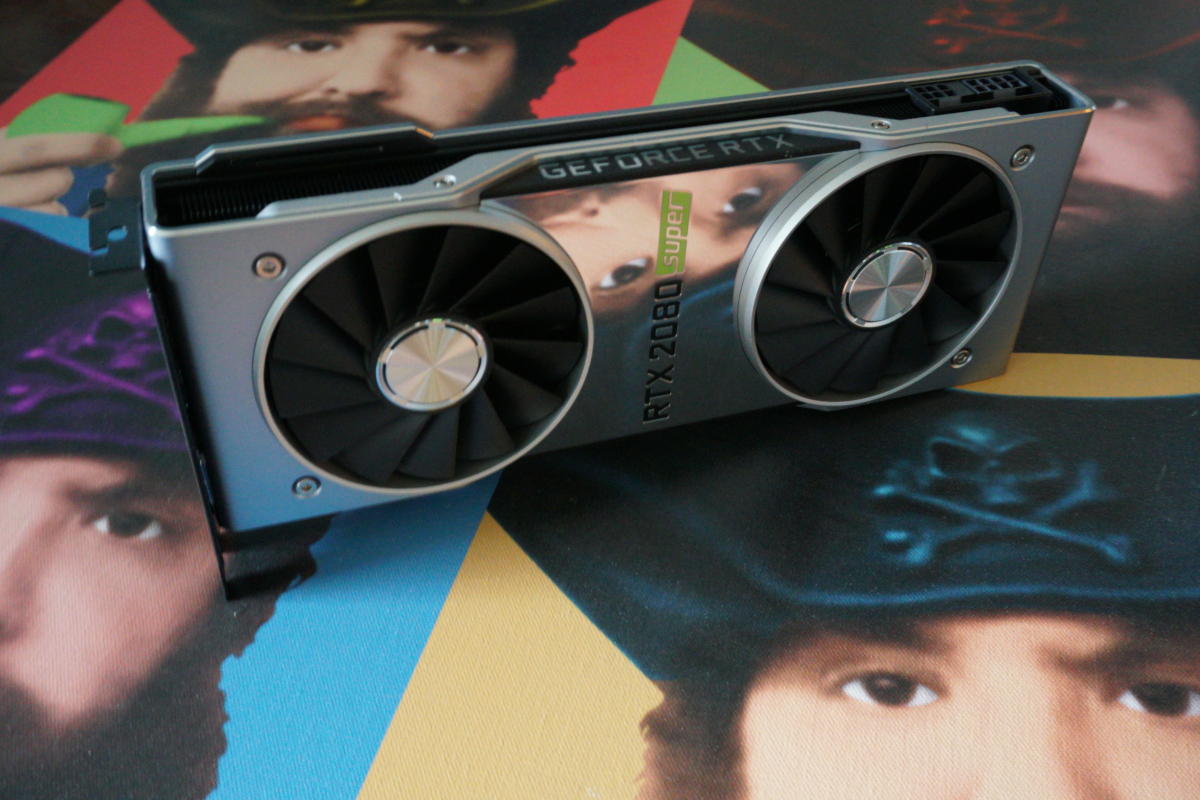 Brad Chacos/IDG
Brad Chacos/IDG If you want to play games with as few modality compromises as possible at 4K resolution, operating room at high refreshen rates at 1440p resolution, and tail't apologise spending four figures on a monstrous GeForce RTX 2080 Ti, the $700 GeForce RTX 2080 Super Founders Edition is worth considering.
The $500 GeForce RTX 2070 Super might be a better value option, though. It's $200 cheaper, but only about 12 percent slower. That's nothing to sternutation at, but crucially, spending that additional $200 on the GeForce RTX 2080 Super doesn't enable any new experiences. Both graphics cards are great for 4K/60 if you shift just about visible options cut down from Ultra, and both graphics card game surpass at fast, no-compromises 1440p play. The pricier wit equitable performs those tasks a little bit faster. That extraoomph makes the RTX 2080 Super a amend option for 4K gaming if you can spare the additional Cash, though.
Nvidia's need to compete against AMD's impressive Radeon RX 5700 series in the $350 to $500 price rate puts the RTX 2080 Super in a tough spot. There was a noticeable performance gap betwixt the original $500 RTX 2070 and $700 RTX 2080 that gave the latter room to shine with a unique performance proposition. Now, the 2070 Super is slightly slower than the innovational 2080, and the 2080 Super is slightly quicker. The rejiggered batting order is good for gamers on a (high) budget but does no favors for the First-rate-fied TU104 flagship.
The somewhat lackluster RTX 2080 Super update cements the GeForce RTX 2080 Ti's position at the top of the GeForce product stack. Nvidia's flagship GPU is costly, but information technology's your only option for 4K/60 gaming with few if any visual compromises, operating theatre high refresh-rate 4K gaming if you don't mind keeping nontextual matter settings at high. It's a monster, and the RTX 2080 Crack can't come close to touch its performance.
Don't buy the original RTX 2070 OR 2080 at this point unless you find them at super-infuse discounts.
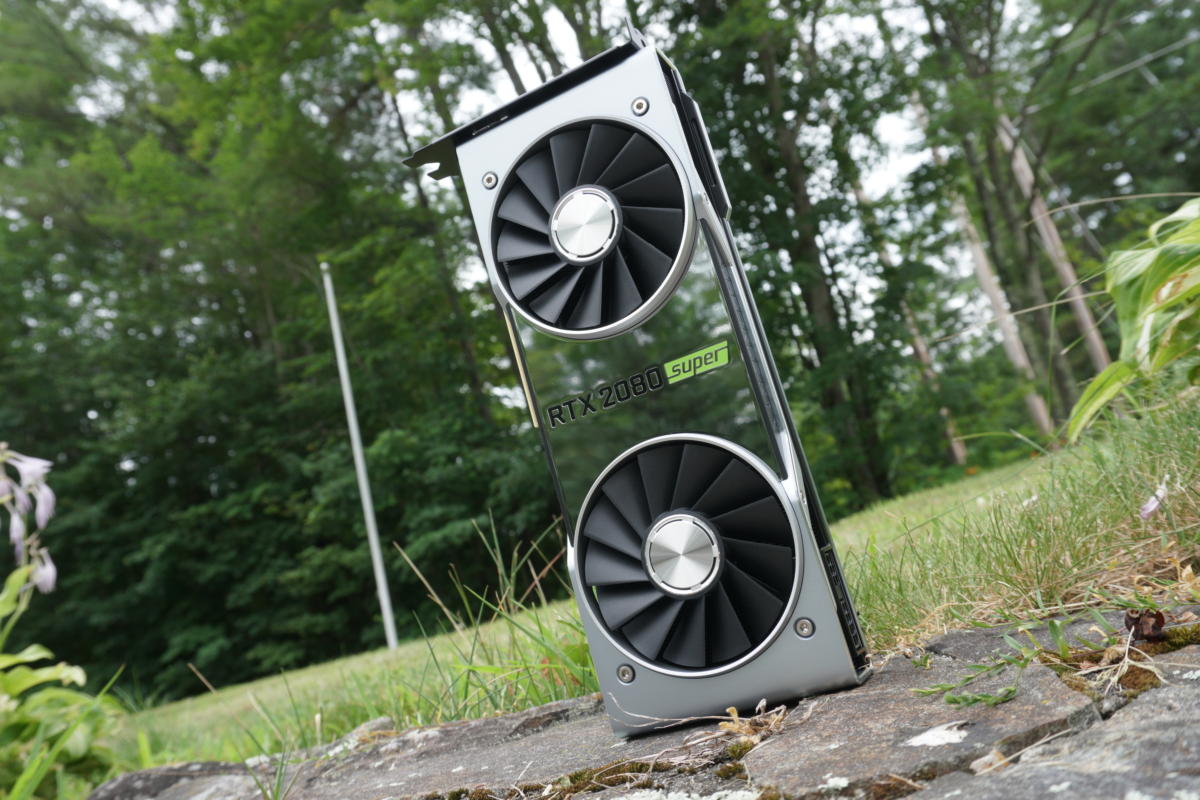 Brad Chacos/IDG
Brad Chacos/IDG Bottom line: The $700 GeForce RTX 2080 Super Founders Edition is a great graphics scorecard, but it isn't a family run ilk Nvidia's lower-priced Super options, disdain beingness the second most powerful consumer GPU ever released. Notably, AMD offers No contest therein price range, which may suffer played into Nvidia's decision not to bump the RTX 2080 Tiptop up to a cut-down version of the RTX 2080 Cordyline terminalis's GPU for a bigger performance spring. But with this release, Nvidia's enthusiast lineup is locked sure the rest of the year. AMD's newfangled RDNA graphics architecture has plenty of room to lucubrate beyond the RX 5700 into more potent variants.
Did Nvidia just leave the door open for AMD to reclaim victory finished an enthusiast-sort out GeForce GPU for the first clip in a long fourth dimension with the RTX 2080 Ace's mild upgrade? The rest on of 2019 could be exciting indeed for graphics card nerds.
Note: When you purchase something later clicking links in our articles, we may earn a small delegation. Read our affiliate link policy for more inside information.
Source: https://www.pcworld.com/article/397804/nvidia-geforce-rtx-2080-super-founders-edition-review.html
Posted by: ehlersorproclen43.blogspot.com


0 Response to "Nvidia GeForce RTX 2080 Super Founders Edition review: A modest upgrade to a powerful GPU - ehlersorproclen43"
Post a Comment